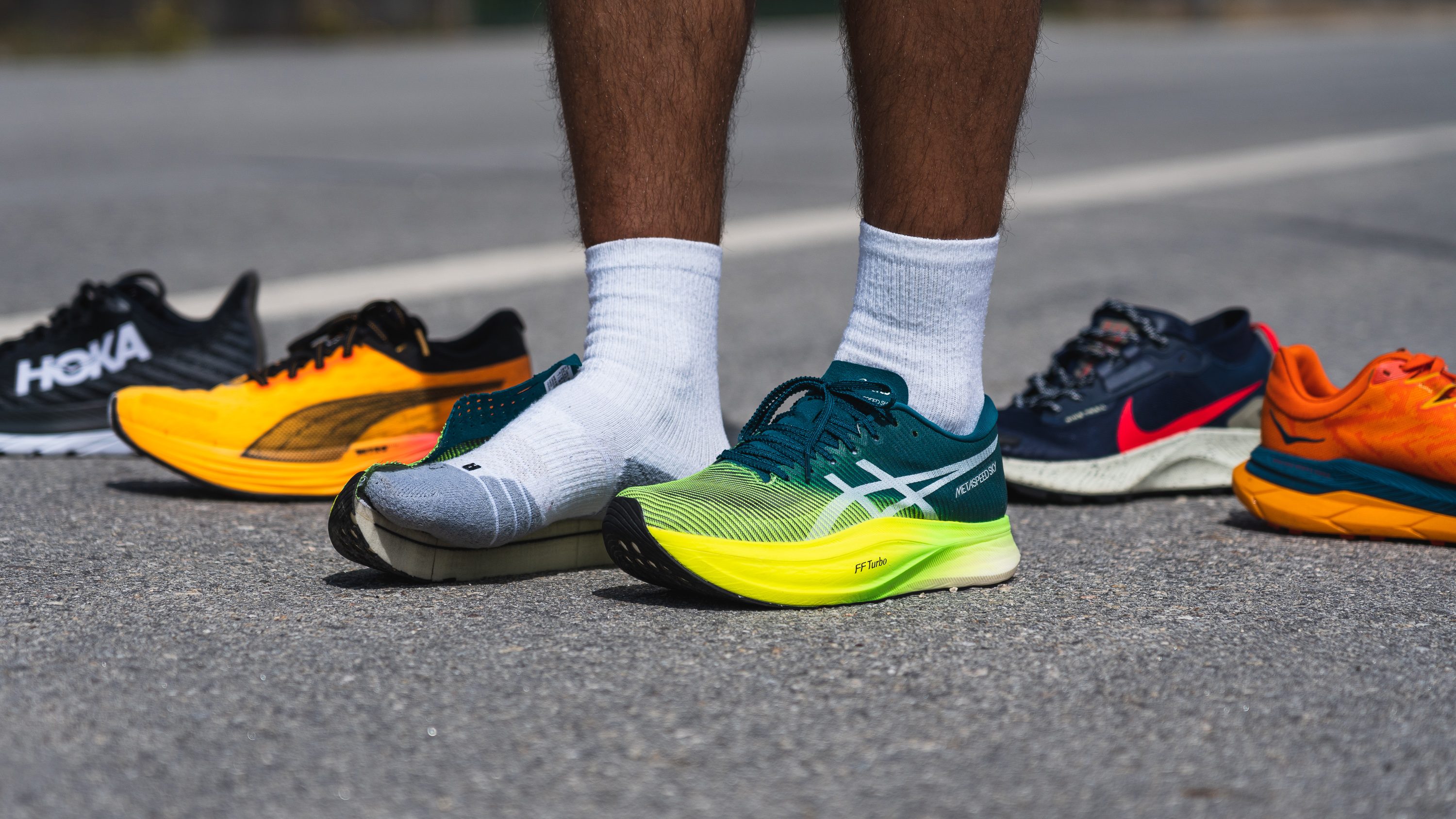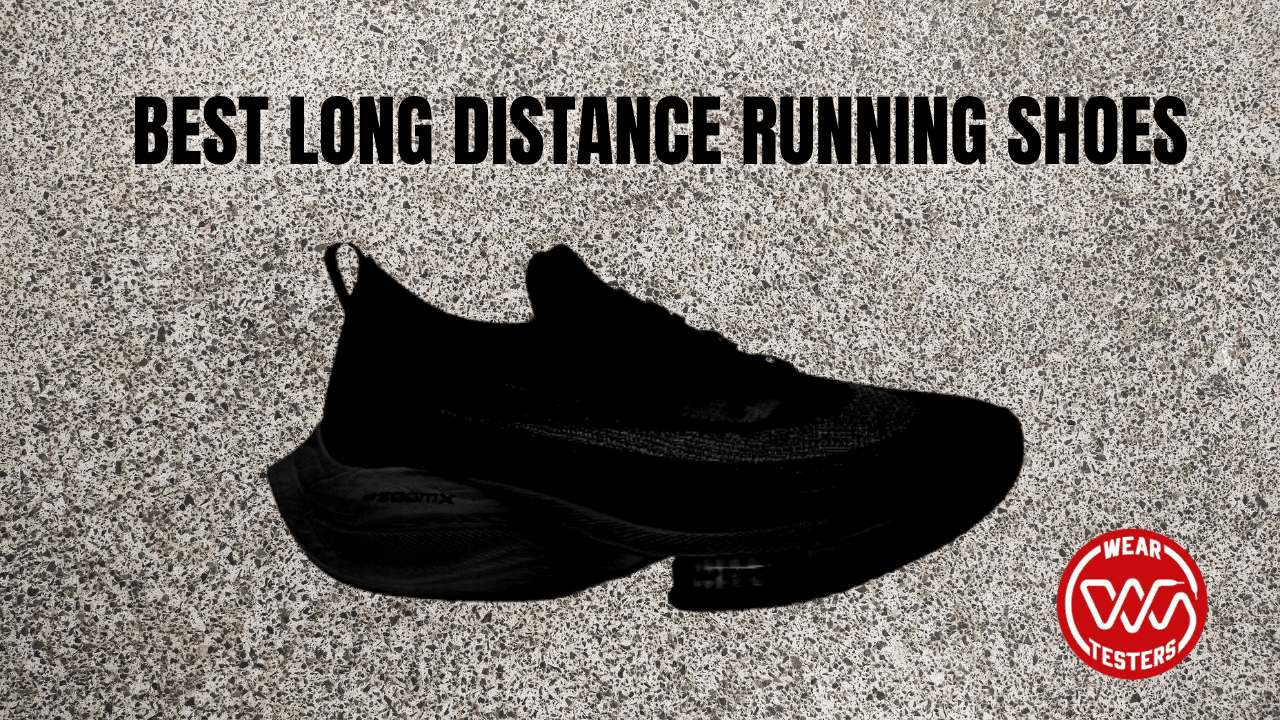Best Running Shoes for Long Distance Track

The best running shoes for long-distance track are Nike Air Zoom Pegasus 38 and Brooks Ghost 14. These shoes offer optimal comfort and support.
Selecting the right running shoes is crucial for long-distance track athletes. Comfort, support, and durability are key factors to consider. Nike Air Zoom Pegasus 38 features responsive cushioning and a secure fit, making it a top choice for many runners.
Brooks Ghost 14 provides excellent shock absorption and a smooth ride, enhancing performance over long distances. Both options are designed to reduce the risk of injury and improve overall running experience. Investing in quality running shoes ensures that you can maintain peak performance and enjoy your long-distance runs without discomfort.

Credit: runrepeat.com
Top Brands
Choosing the best running shoes for long-distance track can be tricky. Many top brands offer great options. Here, we will explore some of the top brands.
Nike
Nike is known for its innovative designs. Their running shoes are popular among athletes.
- Nike Air Zoom Pegasus: Offers excellent cushioning and support.
- Nike React Infinity Run: Known for its stability and comfort.
- Nike ZoomX Vaporfly: Provides superior speed and lightweight feel.
Adidas
Adidas shoes combine style and performance. They are a favorite among runners.
- Adidas Ultraboost: Features responsive cushioning for long distances.
- Adidas Adizero Adios: Ideal for competitive runners needing speed.
- Adidas Solar Boost: Offers great support and energy return.
Asics
Asics shoes are known for their durability. They provide excellent support for long runs.
- Asics Gel-Kayano: Known for its stability and comfort.
- Asics Gel-Nimbus: Offers plush cushioning and support.
- Asics MetaRide: Designed for efficient long-distance running.
| Brand | Model | Key Feature |
|---|---|---|
| Nike | Air Zoom Pegasus | Excellent cushioning |
| Nike | React Infinity Run | Stability and comfort |
| Nike | ZoomX Vaporfly | Superior speed |
| Adidas | Ultraboost | Responsive cushioning |
| Adidas | Adizero Adios | Speed |
| Adidas | Solar Boost | Support and energy return |
| Asics | Gel-Kayano | Stability and comfort |
| Asics | Gel-Nimbus | Plush cushioning |
| Asics | MetaRide | Efficient running |
Key Features
Choosing the best running shoes for long-distance track running is crucial. Key features like cushioning, breathability, and durability can make a huge difference. Let’s dive into each of these important aspects.
Cushioning
Proper cushioning helps reduce impact on your feet and joints. This is vital for long-distance runners. Look for shoes with enhanced midsole cushioning. Materials like EVA foam or gel inserts are excellent choices. They provide a soft, comfortable ride. Here’s a quick overview of popular cushioning materials:
| Material | Benefits |
|---|---|
| EVA Foam | Lightweight, flexible, and shock-absorbing |
| Gel Inserts | Superior shock absorption, ideal for long runs |
| Air Cushioning | Lightweight and provides excellent cushioning |
Breathability
Breathability ensures your feet stay cool and dry. This is especially important for long-distance running. Shoes with mesh uppers are highly recommended. They allow air to flow freely, keeping your feet comfortable. Here are some features to look for:
- Mesh Upper: Lightweight and breathable
- Ventilation Panels: Extra airflow in key areas
- Moisture-Wicking Liners: Keeps feet dry by wicking away sweat
Durability
Durability is key for long-distance running shoes. You need shoes that can withstand many miles. Look for sturdy outsoles made from rubber or carbon rubber. These materials offer great grip and longevity. Key factors contributing to durability include:
- Rubber Outsole: Provides excellent traction and wear resistance
- Reinforced Toe: Extra protection and durability
- Seamless Construction: Reduces wear and tear
By focusing on cushioning, breathability, and durability, you can find the perfect running shoes. Happy running!
Material Choices
Choosing the right running shoes for long-distance track is crucial. The material of the shoe plays a significant role in comfort, durability, and performance. Let’s dive into the different material choices available.
Synthetic
Synthetic materials are popular in modern running shoes. They are lightweight and flexible. These materials often include engineered plastics and polymers. Synthetic shoes are also known for their durability. They resist wear and tear better than natural materials. This makes them a great choice for long-distance running.
Mesh
Mesh materials provide excellent breathability. They help keep your feet cool during long runs. Mesh is lightweight, which reduces the overall weight of the shoe. This can enhance your performance by reducing fatigue. Mesh shoes also offer flexibility and comfort. They adapt to the shape of your feet, providing a snug fit.
Rubber Soles
Rubber soles are essential for running shoes. They provide traction and grip on various surfaces. This is important for stability and safety. Rubber soles are also durable. They can withstand the impact of long-distance running. Additionally, they offer a good level of cushioning. This helps in absorbing shock and reducing strain on your feet.
Fit And Comfort
Choosing the best running shoes for long-distance track requires attention to fit and comfort. These elements are crucial for performance and injury prevention. Below, we delve into key aspects like sizing, arch support, and heel-to-toe drop to help you make an informed decision.
Sizing Guide
Proper sizing is essential for comfort. A shoe that’s too tight or loose can cause blisters or pain.
- Measure your feet at the end of the day.
- Wear the socks you plan to run in.
- Leave about a thumb’s width of space at the toe.
Follow these steps to ensure a snug and comfortable fit.
Arch Support
Your arch type influences the arch support you need.
- Flat Arch: Look for stability shoes.
- Neutral Arch: Neutral shoes are suitable.
- High Arch: Cushioning shoes provide the best comfort.
Choose shoes that support your specific arch type for optimal comfort.
Heel-to-toe Drop
The heel-to-toe drop impacts running style and comfort.
| Drop (mm) | Effect |
|---|---|
| 0-4 mm | Promotes a midfoot strike |
| 5-8 mm | Balanced for most runners |
| 9-12 mm | Promotes a heel strike |
Select the drop that aligns with your running style.
Performance Enhancements
Long-distance running demands shoes that offer maximum performance. These shoes should enhance your run and keep you comfortable. Let’s explore some of the key performance enhancements.
Energy Return
Energy return is crucial for long-distance running. Shoes with high energy return give you a bounce with each step. This helps reduce fatigue and improves your speed.
Look for shoes with foam midsoles. These materials provide excellent cushioning and energy return. Some popular options include:
- Boost Foam
- React Foam
- ZoomX Foam
Stability
Stability is essential for preventing injuries and maintaining balance. Shoes with good stability features support your feet and ankles. They help you stay on track and avoid accidents.
Check for these stability features:
- Firm heel counters
- Wide base
- Arch support
Traction
Traction ensures you have a firm grip on different surfaces. Shoes with good traction help you run smoothly on tracks and trails. They reduce slipping and improve your performance.
Look for shoes with these traction features:
- Durable rubber outsoles
- Multi-directional lugs
- Deep grooves

Credit: runrepeat.com
Innovative Technologies
Running long distances requires the right gear. The best running shoes come with innovative technologies that enhance performance and comfort. This section covers three key technologies in modern running shoes: Flyknit, Boost Foam, and Gel Cushioning.
Flyknit
Flyknit technology offers a snug fit. It feels like a second skin. Nike developed this innovative upper material. Flyknit is both lightweight and strong.
- Provides excellent breathability
- Reduces waste during production
- Ensures a flexible fit
Flyknit material is also durable. It adapts to your foot shape. This ensures maximum comfort during long runs.
Boost Foam
Boost Foam revolutionized running shoe cushioning. Adidas introduced this technology. Boost Foam provides unmatched energy return.
- Made from thousands of energy capsules
- Offers excellent shock absorption
- Performs well in various temperatures
Boost Foam delivers a springy, responsive feel. It keeps your feet comfortable on long runs.
Gel Cushioning
Gel Cushioning is a popular technology. ASICS developed this feature. Gel Cushioning reduces impact during runs.
- Located in the heel and forefoot
- Ensures smooth transitions
- Provides stability and support
Gel Cushioning makes running less stressful on your joints. It enhances overall comfort and performance.
Price Range
Finding the best running shoes for long-distance track can be tricky. Shoes come in various price ranges, offering different features. Let’s explore the best options within these price categories.
Budget Options
If you’re on a tight budget, you can still find good running shoes. Here are some affordable choices that don’t compromise on quality.
| Brand | Model | Price |
|---|---|---|
| Asics | Gel-Contend 5 | $50 |
| Saucony | Cohesion 13 | $55 |
| New Balance | Fresh Foam Arishi | $60 |
Mid-range Choices
Mid-range running shoes offer a balance of cost and performance. These options are perfect for serious runners looking for value.
- Nike Air Zoom Pegasus 38 – $120
- Brooks Ghost 14 – $130
- Adidas Ultraboost 21 – $140
Premium Picks
For those who want the best, premium running shoes offer top-notch features. These shoes are designed for ultimate comfort and performance.
- Hoka One One Bondi 7 – $150
- Asics Gel-Kayano 27 – $160
- Nike ZoomX Vaporfly NEXT% – $250

Credit: weartesters.com
User Reviews
User reviews provide valuable insights for selecting the best running shoes for long-distance tracks. They highlight the actual experiences of runners, offering a glimpse into the pros and cons of various models. Below, we break down the user reviews into three categories: Pros, Cons, and Real-World Feedback.
Pros
Many users rave about the comfort and support provided by these shoes. Runners often mention the lightweight design, which makes long-distance running easier. Here are some key advantages highlighted by users:
- Cushioning: Excellent shock absorption reduces foot strain.
- Durability: High-quality materials ensure the shoes last longer.
- Breathability: Mesh uppers keep feet cool and dry.
- Fit: Snug fit prevents blisters and discomfort.
Cons
Some users have pointed out a few drawbacks. Knowing these can help manage expectations and make a more informed choice. Common cons mentioned include:
- Price: High cost compared to other options.
- Break-in Period: Some models need time to feel comfortable.
- Arch Support: Not suitable for flat feet.
- Weight: Heavier models may slow down runners.
Real-world Feedback
Real-world feedback provides a closer look at how these shoes perform. Here are some examples of user experiences:
| Runner | Experience |
|---|---|
| John D. | Completed a marathon with no blisters or pain. |
| Jane S. | Found the shoes perfect for daily training. |
| Mike T. | Needed a week to break in, then loved them. |
| Lisa K. | Felt the price was high but worth the quality. |
These reviews provide an honest look at the best running shoes for long-distance tracks. They help you decide which pair suits your needs.
Buying Tips
Finding the perfect running shoes for long-distance track can be tricky. You need to consider many factors to make the best choice. Here are some buying tips to help you find the ideal pair of running shoes.
Trial Runs
Always test the shoes before making a final decision. Many stores offer trial runs to ensure the shoes fit well. During a trial run, pay attention to comfort and support. Are the shoes snug without being too tight? Do they provide adequate cushioning?
A good trial run can help you avoid blisters and discomfort. It’s essential for long-distance running, where every step matters.
Return Policies
Check the store’s return policy before you buy. A flexible return policy allows you to exchange or return the shoes if they don’t meet your needs. Look for a return window of at least 30 days.
Make sure the shoes are in good condition if you need to return them. Keep the original packaging and receipt for hassle-free returns.
Seasonal Sales
Take advantage of seasonal sales to get the best deals. Many brands offer discounts during specific times of the year. These sales can help you save money on high-quality running shoes.
| Season | Typical Discount |
|---|---|
| Spring | 10-20% |
| Summer | 15-25% |
| Fall | 20-30% |
| Winter | 25-40% |
Plan your purchase around these sales to maximize savings. You can often find last season’s models at a lower price, which still offer excellent performance.
Maintenance
Maintaining your long-distance running shoes is essential for their longevity. Proper care ensures your shoes perform well and stay comfortable. Here are some tips on cleaning, storing, and understanding the lifespan of your running shoes.
Cleaning Tips
Clean your shoes regularly to keep them fresh. Follow these steps:
- Remove the insoles and laces.
- Brush off loose dirt with a soft brush.
- Mix mild soap with warm water.
- Use a cloth to scrub the shoes gently.
- Rinse with clean water and air dry.
Do not use a washing machine or dryer. This can damage the materials.
Storage Advice
Store your running shoes properly to extend their lifespan:
- Keep them in a cool, dry place.
- Avoid direct sunlight and extreme temperatures.
- Use shoe trees to maintain their shape.
- Do not stack heavy items on top of them.
Proper storage helps prevent wear and tear.
Lifespan
Understand the lifespan of your running shoes:
| Shoe Type | Approximate Lifespan (Miles) |
|---|---|
| Road Running Shoes | 300-500 |
| Trail Running Shoes | 500-700 |
Track your mileage to know when to replace your shoes. Signs of wear include:
- Worn-out soles.
- Decreased cushioning.
- Discomfort or pain while running.
Regularly inspect your shoes for these signs.
Frequently Asked Questions
What Are The Best Shoes For Long-distance Running?
The best shoes for long-distance running offer cushioning, support, and durability. Look for lightweight materials and responsive midsoles. Brands like Nike, Adidas, and Asics are popular choices among long-distance runners.
How Do I Choose Running Shoes For Long Distances?
To choose running shoes for long distances, consider your foot type, gait, and terrain. Look for shoes with good arch support and cushioning. Try different brands to find the perfect fit.
Are Cushioned Running Shoes Better For Long Distances?
Yes, cushioned running shoes are better for long distances. They reduce impact and provide comfort. Look for shoes with responsive midsoles and good shock absorption.
How Often Should I Replace My Running Shoes?
Replace your running shoes every 300-500 miles. Worn-out shoes can cause injuries and discomfort. Check for signs of wear and tear regularly.
Conclusion
Selecting the best running shoes for long-distance track is essential. The right pair enhances performance and comfort. Prioritize fit, support, and durability. Happy running!

